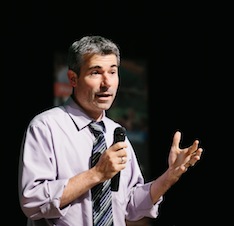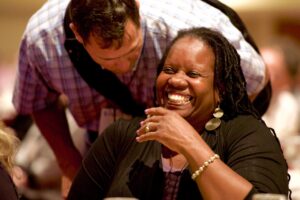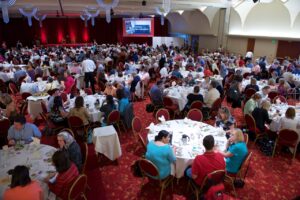
Richard Culatta is the former director of the Office of Educational Technology for the U.S. Department of Education, where he focused on educational innovation. He’s a leading authority on using technology in higher education, K-12, and workplace learning environments. Culatta will discuss new frontiers in educational technology for online learning in his keynote address at the University of Wisconsin-Madison’s Distance Teaching & Learning Conference on August 9-11.

At the Department of Education, Culatta explored technology’s role in creating a personalized learning experience and improving access to education. He’s particularly interested in finding ways to leverage analytics and human-centered design to improve outcomes for students.
Before joining the federal government, Culatta worked for the McKay School of Education at Brigham Young University. He is currently serving as Rhode Island’s chief innovation officer.
Culatta’s keynote address at the Distance Teaching & Learning Conference, “Technology as a Tool to Reimagine Learning,” will focus on innovations in educational technology and online learning from his work at the national level. He’ll address some of the challenges higher education faces and offer solutions in the form of new tools and approaches that practitioners and institutions can begin adopting right away. In the following interview, he previews his talk and explains his latest ideas about personalized learning experiences.
What will you emphasize in your keynote address at the Distance Teaching & Learning Conference? What impact would you like to have?
Culatta: I’m concerned that in our attempt to be rigorous around outcome data and models for learning, which is all incredibly important, we’ve lost a focus on user experience. In the tech industry, there’s a huge emphasis on very small changes—for example, the size of buttons in an app or the tone of an incoming message—that welcome the users to participate. We don’t have that focus on user experience in distance learning, and I think we really need it. I hope people will walk away from our conversation thinking about how to make changes in their design based on the experience we’re creating for the user, rather than just focusing on the number of people who passed the test or the number of people who enroll in a course.

Here’s an example: when we want students to sign up for a course, we give them a course catalog, and the courses are generally listed alphabetically—probably the most useless way to present that information to a student. The most helpful way would be to say, “What are your interests? What are your time constraints?” And then, based on that information, provide some suggestions for optimal pathways through learning experiences.
How are K-12 and higher education doing in addressing current educational challenges? What do they need to work on?
We don’t do a very good job of bridging K-12 and higher education, and there are solutions in each area that the other would benefit from knowing.
When I started my career in higher ed, it was ahead of K-12 in terms of innovation. But that has flipped. In the K-12 space, students are taking advantage of personalized learning experiences and using technology tools to create and design, rather than just being consumers of information. That’s an area where higher ed is falling behind. I’d like to see higher ed think about how we can use technology to empower students to be digital creators and not just consumers.
On the flip side, more and more higher education institutions are figuring out how to blur the lines between learning and practice. This is happening through internships, fellowships, undergraduate research opportunities, and other valuable learning experiences that happen outside of the classroom. That connection to the “real world” is an area that K-12 could learn from.

Those are just two areas where I’d love to cross-pollinate K-12 and higher education.
What changes will higher education need to make in order to best serve today’s students?
We have to be more responsive to student needs. In a world where personalization is becoming the norm, the learning experience offered by most higher ed institutions is still monolithic. It doesn’t matter who you are, it doesn’t matter what your background is, it doesn’t matter what your interests and passions are—here are the four courses you need to take if you want to get through this program. There’s no effort to figure out how to tailor the approach to individual students.
Traditionally there has been little competition when it comes to models of higher education. With the invention of massive open online courses and other nontraditional online learning experiences, students may start to wonder, “Why should I spend all this money to sit through a course that uses old technology, is disconnected from other parts of my life, and doesn’t adapt to my needs at all?” That question is becoming harder to answer for higher ed institutions that have not begun exploring new learning models. So we have to figure out how to tailor education to students’ individual needs better.
In terms of the business model of higher education, one of the most expensive things we do is sit students in buildings and lecture at them. It’s an expensive use of space and of everybody’s time. So we’ll have to struggle with the question of how to use distance learning not to replace the physical experience of schools, but to augment it.

What are some of the most valuable innovations in educational technology and online learning?
Tools that show students where they’re at in the learning process and help them see their progress toward their learning goals are very powerful. I like to call these learning positioning systems–like a GPS for learning.
I’m interested in technologies that help students plan their learning experiences. There are some interesting tools that allow students to create a personal learning plan based on their particular situation.
We can also do a lot more with openly licensed resources. Without the barrier of copyright laws, students and faculty can be engaged in the process of continually improving course materials.
What interests you most about speaking at the Distance Teaching & Learning Conference?
The conference attracts a very thoughtful group of people who are willing to question traditional approaches. The audience is deeply concerned about providing quality learning experiences for a diverse group of students.
I also really like events that bring people together across silos, as this one does. It creates a meaningful conversation that doesn’t happen as much among people who all do the same thing.